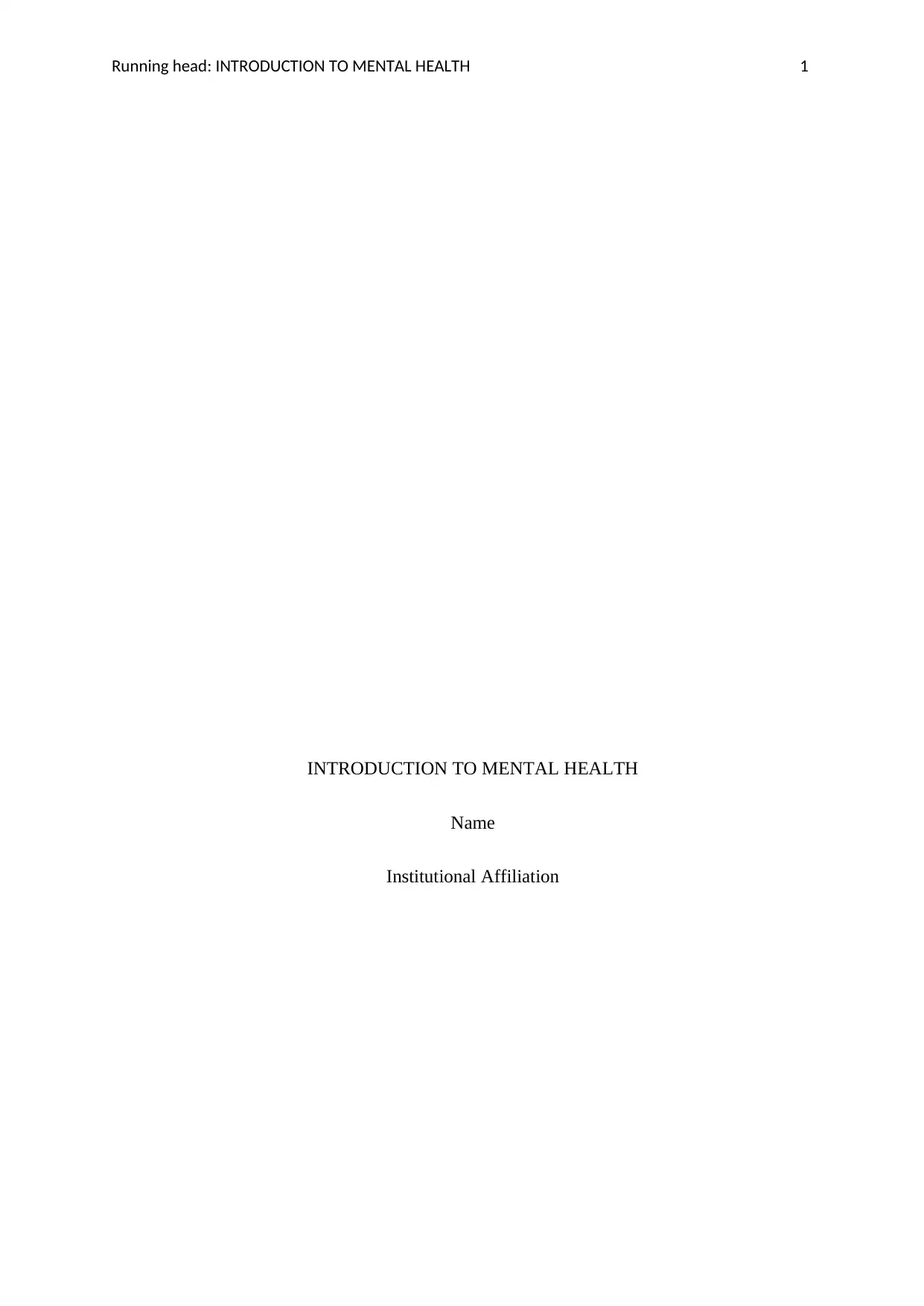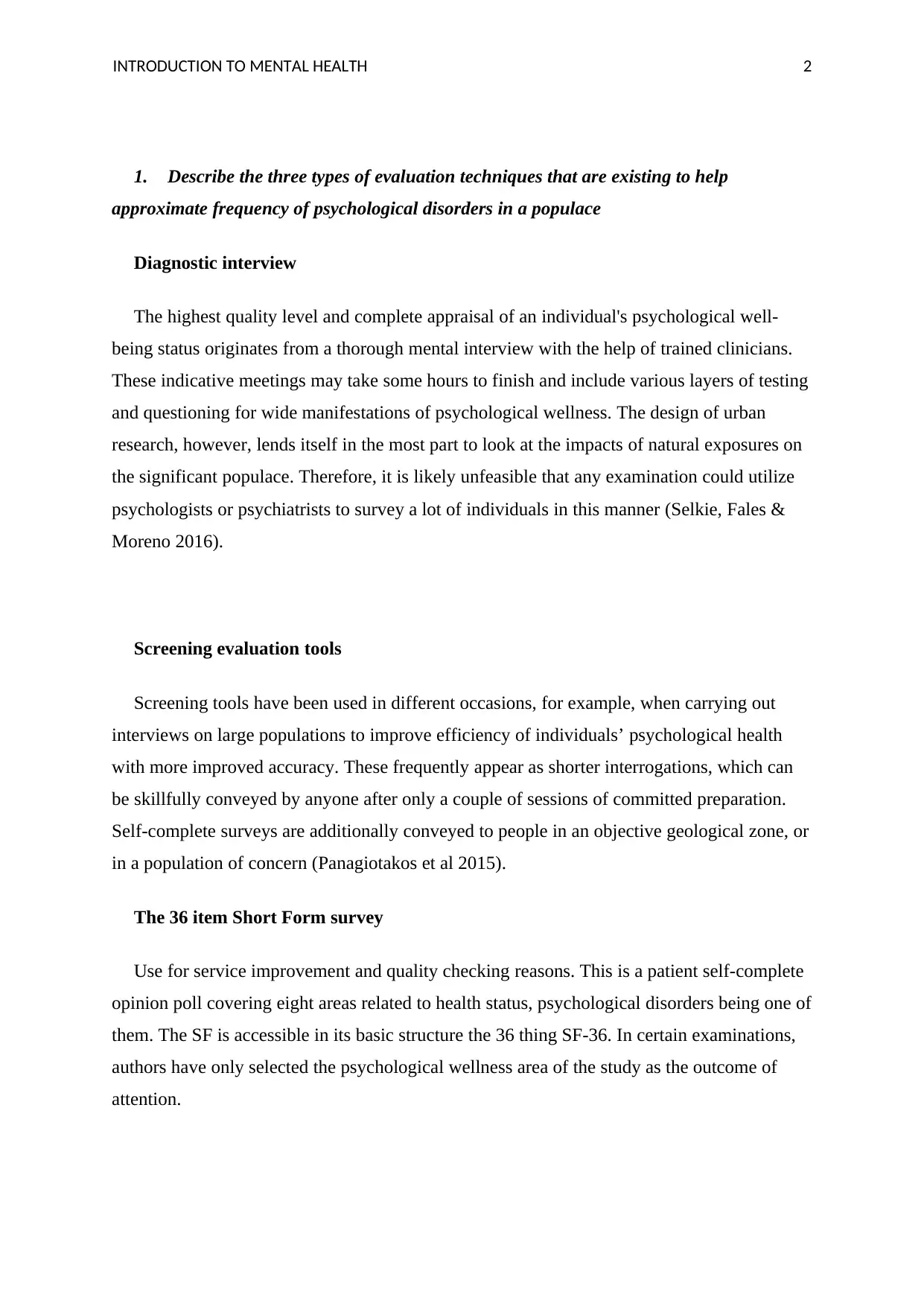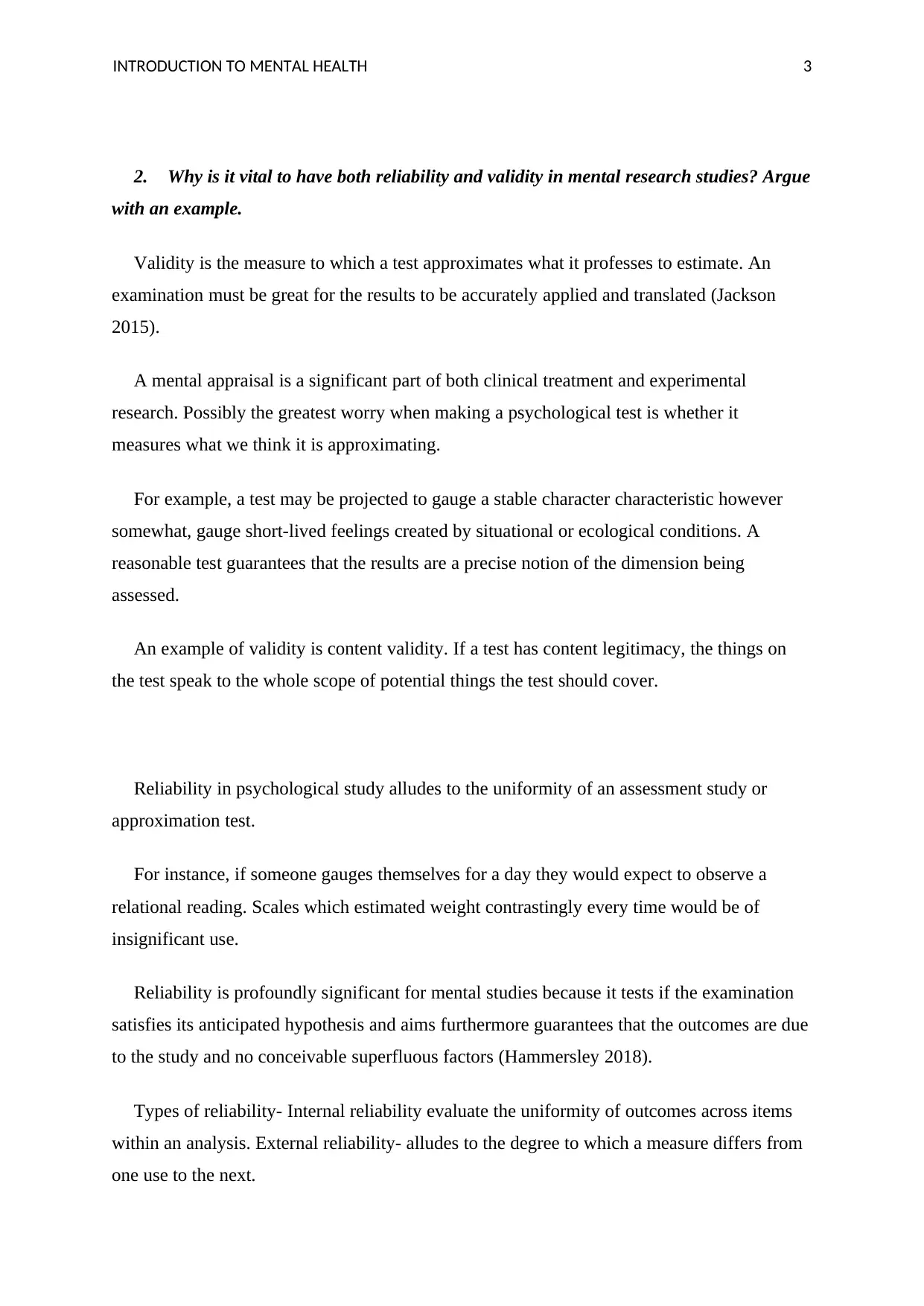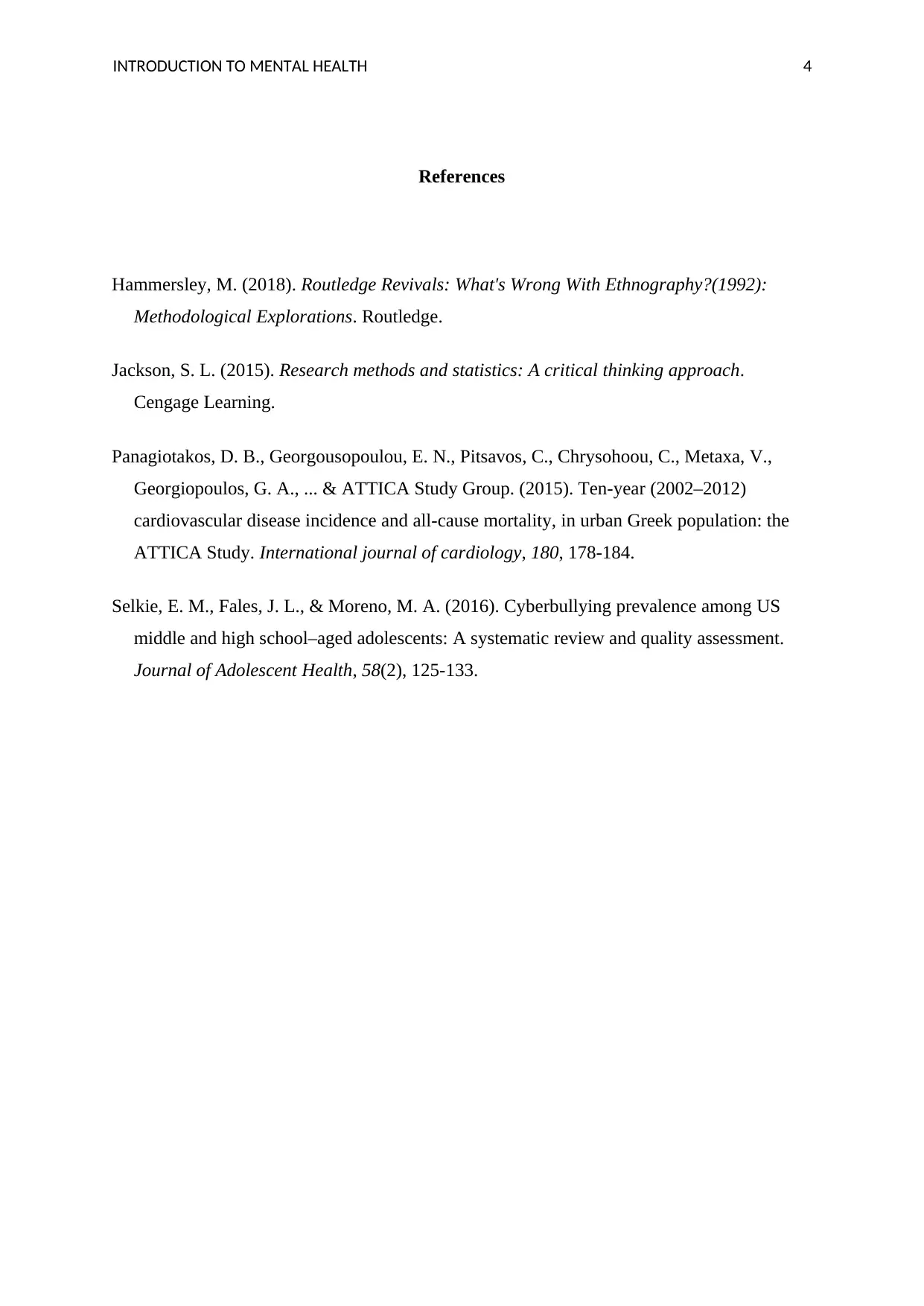Introduction to Mental Health Case Study 2022
VerifiedAdded on 2022/10/08
|4
|757
|20
AI Summary
Contribute Materials
Your contribution can guide someone’s learning journey. Share your
documents today.

Running head: INTRODUCTION TO MENTAL HEALTH 1
INTRODUCTION TO MENTAL HEALTH
Name
Institutional Affiliation
INTRODUCTION TO MENTAL HEALTH
Name
Institutional Affiliation
Secure Best Marks with AI Grader
Need help grading? Try our AI Grader for instant feedback on your assignments.

INTRODUCTION TO MENTAL HEALTH 2
1. Describe the three types of evaluation techniques that are existing to help
approximate frequency of psychological disorders in a populace
Diagnostic interview
The highest quality level and complete appraisal of an individual's psychological well-
being status originates from a thorough mental interview with the help of trained clinicians.
These indicative meetings may take some hours to finish and include various layers of testing
and questioning for wide manifestations of psychological wellness. The design of urban
research, however, lends itself in the most part to look at the impacts of natural exposures on
the significant populace. Therefore, it is likely unfeasible that any examination could utilize
psychologists or psychiatrists to survey a lot of individuals in this manner (Selkie, Fales &
Moreno 2016).
Screening evaluation tools
Screening tools have been used in different occasions, for example, when carrying out
interviews on large populations to improve efficiency of individuals’ psychological health
with more improved accuracy. These frequently appear as shorter interrogations, which can
be skillfully conveyed by anyone after only a couple of sessions of committed preparation.
Self-complete surveys are additionally conveyed to people in an objective geological zone, or
in a population of concern (Panagiotakos et al 2015).
The 36 item Short Form survey
Use for service improvement and quality checking reasons. This is a patient self-complete
opinion poll covering eight areas related to health status, psychological disorders being one of
them. The SF is accessible in its basic structure the 36 thing SF-36. In certain examinations,
authors have only selected the psychological wellness area of the study as the outcome of
attention.
1. Describe the three types of evaluation techniques that are existing to help
approximate frequency of psychological disorders in a populace
Diagnostic interview
The highest quality level and complete appraisal of an individual's psychological well-
being status originates from a thorough mental interview with the help of trained clinicians.
These indicative meetings may take some hours to finish and include various layers of testing
and questioning for wide manifestations of psychological wellness. The design of urban
research, however, lends itself in the most part to look at the impacts of natural exposures on
the significant populace. Therefore, it is likely unfeasible that any examination could utilize
psychologists or psychiatrists to survey a lot of individuals in this manner (Selkie, Fales &
Moreno 2016).
Screening evaluation tools
Screening tools have been used in different occasions, for example, when carrying out
interviews on large populations to improve efficiency of individuals’ psychological health
with more improved accuracy. These frequently appear as shorter interrogations, which can
be skillfully conveyed by anyone after only a couple of sessions of committed preparation.
Self-complete surveys are additionally conveyed to people in an objective geological zone, or
in a population of concern (Panagiotakos et al 2015).
The 36 item Short Form survey
Use for service improvement and quality checking reasons. This is a patient self-complete
opinion poll covering eight areas related to health status, psychological disorders being one of
them. The SF is accessible in its basic structure the 36 thing SF-36. In certain examinations,
authors have only selected the psychological wellness area of the study as the outcome of
attention.

INTRODUCTION TO MENTAL HEALTH 3
2. Why is it vital to have both reliability and validity in mental research studies? Argue
with an example.
Validity is the measure to which a test approximates what it professes to estimate. An
examination must be great for the results to be accurately applied and translated (Jackson
2015).
A mental appraisal is a significant part of both clinical treatment and experimental
research. Possibly the greatest worry when making a psychological test is whether it
measures what we think it is approximating.
For example, a test may be projected to gauge a stable character characteristic however
somewhat, gauge short-lived feelings created by situational or ecological conditions. A
reasonable test guarantees that the results are a precise notion of the dimension being
assessed.
An example of validity is content validity. If a test has content legitimacy, the things on
the test speak to the whole scope of potential things the test should cover.
Reliability in psychological study alludes to the uniformity of an assessment study or
approximation test.
For instance, if someone gauges themselves for a day they would expect to observe a
relational reading. Scales which estimated weight contrastingly every time would be of
insignificant use.
Reliability is profoundly significant for mental studies because it tests if the examination
satisfies its anticipated hypothesis and aims furthermore guarantees that the outcomes are due
to the study and no conceivable superfluous factors (Hammersley 2018).
Types of reliability- Internal reliability evaluate the uniformity of outcomes across items
within an analysis. External reliability- alludes to the degree to which a measure differs from
one use to the next.
2. Why is it vital to have both reliability and validity in mental research studies? Argue
with an example.
Validity is the measure to which a test approximates what it professes to estimate. An
examination must be great for the results to be accurately applied and translated (Jackson
2015).
A mental appraisal is a significant part of both clinical treatment and experimental
research. Possibly the greatest worry when making a psychological test is whether it
measures what we think it is approximating.
For example, a test may be projected to gauge a stable character characteristic however
somewhat, gauge short-lived feelings created by situational or ecological conditions. A
reasonable test guarantees that the results are a precise notion of the dimension being
assessed.
An example of validity is content validity. If a test has content legitimacy, the things on
the test speak to the whole scope of potential things the test should cover.
Reliability in psychological study alludes to the uniformity of an assessment study or
approximation test.
For instance, if someone gauges themselves for a day they would expect to observe a
relational reading. Scales which estimated weight contrastingly every time would be of
insignificant use.
Reliability is profoundly significant for mental studies because it tests if the examination
satisfies its anticipated hypothesis and aims furthermore guarantees that the outcomes are due
to the study and no conceivable superfluous factors (Hammersley 2018).
Types of reliability- Internal reliability evaluate the uniformity of outcomes across items
within an analysis. External reliability- alludes to the degree to which a measure differs from
one use to the next.

INTRODUCTION TO MENTAL HEALTH 4
References
Hammersley, M. (2018). Routledge Revivals: What's Wrong With Ethnography?(1992):
Methodological Explorations. Routledge.
Jackson, S. L. (2015). Research methods and statistics: A critical thinking approach.
Cengage Learning.
Panagiotakos, D. B., Georgousopoulou, E. N., Pitsavos, C., Chrysohoou, C., Metaxa, V.,
Georgiopoulos, G. A., ... & ATTICA Study Group. (2015). Ten-year (2002–2012)
cardiovascular disease incidence and all-cause mortality, in urban Greek population: the
ATTICA Study. International journal of cardiology, 180, 178-184.
Selkie, E. M., Fales, J. L., & Moreno, M. A. (2016). Cyberbullying prevalence among US
middle and high school–aged adolescents: A systematic review and quality assessment.
Journal of Adolescent Health, 58(2), 125-133.
References
Hammersley, M. (2018). Routledge Revivals: What's Wrong With Ethnography?(1992):
Methodological Explorations. Routledge.
Jackson, S. L. (2015). Research methods and statistics: A critical thinking approach.
Cengage Learning.
Panagiotakos, D. B., Georgousopoulou, E. N., Pitsavos, C., Chrysohoou, C., Metaxa, V.,
Georgiopoulos, G. A., ... & ATTICA Study Group. (2015). Ten-year (2002–2012)
cardiovascular disease incidence and all-cause mortality, in urban Greek population: the
ATTICA Study. International journal of cardiology, 180, 178-184.
Selkie, E. M., Fales, J. L., & Moreno, M. A. (2016). Cyberbullying prevalence among US
middle and high school–aged adolescents: A systematic review and quality assessment.
Journal of Adolescent Health, 58(2), 125-133.
1 out of 4
Your All-in-One AI-Powered Toolkit for Academic Success.
+13062052269
info@desklib.com
Available 24*7 on WhatsApp / Email
![[object Object]](/_next/static/media/star-bottom.7253800d.svg)
Unlock your academic potential
© 2024 | Zucol Services PVT LTD | All rights reserved.